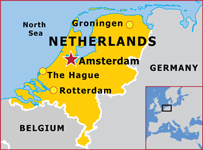Holland

The Netherlands Overview
The Netherlands is renowned for being unremittingly flat, with traditional images of canals, windmills and tulips complementing its new face as a modern European nation, so impressively demonstrated when The Netherlands co-hosted Euro 2000 with Belgium. Its eclectic past reads like a ‘who’s who’ of European nations as everyone from the Romans and the Gauls, right through to the Hapsburgs and the Spanish, influenced its destiny before the country finally emerged with its current borders in 1830. It is easy to imagine The Netherlands as just Amsterdam; the nation’s capital city is one of the most visually stunning in the world, where you can also delve through centuries of history aboard a canal boat or explore the array of excellent museums. The Netherlands is far more than just its capital, though, with a string of impressive cities including Arnhem, The Hague and Rotterdam. Rotterdam has picked itself up from almost total devastation in World War II to emerge as Europe’s (and indeed one of the world’s) biggest ports and a leader in urban regeneration. Out in the countryside, any sense of monotony you may have is soon broken by stunning medieval towns like Utrecht and Delft. Holland’s main natural attraction is its wide swathe of coastline, much of it peppered with artificial sea walls and inland seas, as The Netherlands fights its never-ending battle with the North Sea.
General Information
Area: 41,528 sq km (16,034 sq miles)
Population: 16,254,933
Capital: Amsterdam
Geography: The Netherlands shares borders to the south with Belgium and the east with Germany, while the North Sea lies to the north and west. Large areas of The Netherlands have been reclaimed from the sea and consequently one-fifth of the country lies below sea level. The country is flat and level and is criss-crossed by rivers and canals. Areas reclaimed from the sea, known as polders, are extremely fertile. The landscape is broken by the forest of Arnhem, the bulb fields in the west, the lakes of central and northern areas and coastal dunes which are among the most impressive in Europe.
Language: Dutch. English, French and German are widely spoken.
Money
Currency: EURO
Credit Cards: MasterCard, American Express, Diners Club and VISA are all widely accepted.
Travelers Checks: Widely accepted.
Banking Hours: Monday 1pm-4pm and 9am-4pm Tuesday-Friday.
International Travel
Air: The Netherlands’ national airline is Royal Dutch Airlines (KLM) (www.klm.com)
Approximate flight times:
London to Amsterdam is 1 hour 20 minutes
New York to Amsterdam is 7 hours
Chicago to Amsterdam is 10 hours 40 minutes
Los Angeles to Amsterdam is 14 hours 15 minutes
International Airports
Amsterdam (AMS) (Schiphol) (www.schiphol.nl) is 15km (9 miles) southwest of the city (travel time by train 20 minutes). KLM buses provide a daily service from 6am-12mid-night departing every 15-30 minutes.
Rotterdam (RTM) (Zestienhoven) (www.rotterdam-airport.nl) is 8km (5 miles) northwest of the city (travel time 15 minutes). Bus no. 33 departs every 30 minutes from 7am-7pm. Return is from Central Station, Knisplein from 6:30am-6:30pm Taxis are available.
Social & Business Customs
Food
There are few dishes which can be described as quintessentially Dutch and those that fall into this category are a far cry from the elaborate creations of French or Italian cuisine. Almost every large town, however, has a wide range of restaurants specializing in their own brands of international dishes including Chinese, Italian, French, Balkan, Spanish, German, American, British and Indonesian. The most common daytime snack are broodjes (sandwiches) and are served in the ubiquitous sandwich bars broodjeswinkels. Filled pancakes are also popular. Lightly salted “green” herring can be bought from street stalls. They are held by the tail and slipped down into the throat. Seafood dishes are often excellent, particularly in Amsterdam or Rotterdam and include gebakken zeetong (fried sole), Lekkerbekjes (fried whiting), royal imperial oysters, shrimps, mussels, lobster and eel.
Drink
The local spirit is jenever (Dutch gin), normally taken straight and chilled as a chaser with a glass of beer but it is sometimes drunk with cola or vermouth. It comes in many varieties depending on the spices used. Dutch beer is excellent. It is a light, gassy pils type of beer, always served chilled, generally in small glasses.
Nightlife
Large cities have sophisticated nightclubs and discos but late opening bars and cafés are just as popular in provincial towns. Amsterdam is a cosmopolitan city with some of the liveliest nightlife in Europe. There are legal casinos in Amsterdam, Breda, Eindhoven, Den Haag, Groningen, Nymegen, Rotterdam, Zandvoort, Valkenburg and Scheveningen.
Shopping
Special purchases include blue pottery from Delft and pottery from Makkum and Workum, costume dolls, silverware from Schoonhoven, glass and crystal from Leerdam and diamonds from Amsterdam.
Shopping Hours
Mon 11am-6pm; Tues-Fri 9am-6pm; Sat 9am-5pm. Big cities: 8am-8pm Monday – Saturday; 12noon-5pm Sunday.
Social
It is customary to shake hands. Hospitality is very much the same as for the rest of Europe and America. It is customary to take a small gift if invited for a meal. Casual wear is widely acceptable. Men are expected to wear a suit for business and social functions. Formal wear may be required for smart restaurants, bars and clubs.
Tipping
All hotels and restaurants include 15% service and VAT. It is customary to leave small change when paying a bill. EUR 1 is usual for porters, doormen and taxi drivers. Hairdressers and barbers have inclusive service prices.
Business
Appointments are necessary and visiting cards are exchanged. The Dutch expect a certain standard of dress fro business occasions. Best months for business visits are March to May and September to November. Practical information can be obtained from the Economic Information Service in The Hague: tel (70)3798933, fax (70)3797878. the majority of Dutch business people speak extremely good English and promotional literature can be disseminated in English. Office hours: 8:30am-5pm Monday to Friday.
Climate
Mild maritime climate. Summers are generally warm with changeable periods but excessively hot weather is rare. Winters can be fairly cold with the possibility of some snow. Rainfall is prevalent all year.


